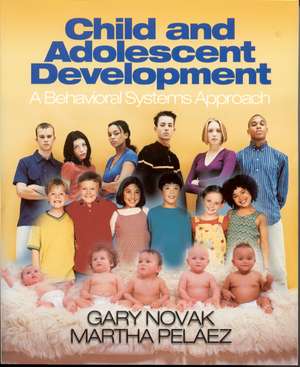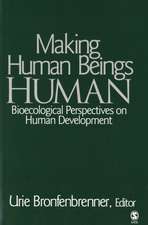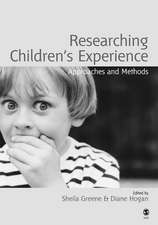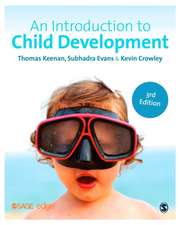Child and Adolescent Development: A Behavioral Systems Approach
Autor Gary D. Novak, Martha Pelaezen Limba Engleză Paperback – 20 ian 2004
`The book is a very good read. It is also truly unique in the field of developmental psychology…a field in which far too little attention is typically paid to the obvious fact that children's development involves learning' - Michael W. Vasey, The Ohio State University
`Presents behavioral principles in a systematic and fairly sophisticated manner (as contrasted with the simplistic treatment those principles often receive in textbooks of introductory or developmental psychology), while linking up with contemporary conceptions of dynamic systems. . . straightforward and clear, accessible to undergraduates without coming across as simplistic' - Philip N. Hineline, Temple University
`Most useful for the subset of college instructors who are process oriented and focus upon a sophisticated multilevel conceptual approach that considers the environmental impact on behavioral development and the concurrent impact of the developing individual upon the significant figures in its environment. . . . No other undergraduate text presents such a clear interweaving of developmental considerations and concepts with learning concepts' - Jacob L. Gewirtz, Florida International
`This book is unique because of its blending of behavior analysis and its dynamical systems point of view. . . . The authors' writing style is very engaging and accessible to undergraduate level students [and] the level of scholarship is excellent, particularly in its depth when dealing with theoretical issues. . . . A cutting-edge look at a behavior analytic view of child and adolescent development' - Pete Peterson, Johnson County Community College
There are two fundamental questions in developmental psychology – what develops and how does it develop? The "what" is largely a question of developmental structure and describes development, while the "how" is primarily a question of function or process and explains development. Developmental psychology has become increasingly focused on the process aspect, but many texts do not provide readers with a clear perspective of how development actually occurs.
Child and Adolescent Development: A Behavioral Systems Approach integrates the views of dynamical systems concepts with a behavioral view of development. This combination of perspectives is unique and from it something new emerges – "a behavioral systems approach" to development. It is an approach that incorporates both personal and environmental influences and the constant reciprocal interactions between nature and nurture.
The book emphasizes learning as the major process for change in development and the integration of environmental influences with genetic and historical factors. Authors Gary Novak and Martha Pelaez provide a coherent understanding of the learning process in childhood and adolescence and present successful interventions to minimize typical problematic behavior during this period.
Preț: 1209.83 lei
Preț vechi: 1657.31 lei
-27% Nou
Puncte Express: 1815
Preț estimativ în valută:
231.53€ • 240.83$ • 191.14£
231.53€ • 240.83$ • 191.14£
Carte tipărită la comandă
Livrare economică 14-28 aprilie
Preluare comenzi: 021 569.72.76
Specificații
ISBN-13: 9780761926986
ISBN-10: 0761926984
Pagini: 632
Dimensiuni: 187 x 232 x 33 mm
Greutate: 1.03 kg
Ediția:New.
Editura: SAGE Publications
Colecția Sage Publications, Inc
Locul publicării:Thousand Oaks, United States
ISBN-10: 0761926984
Pagini: 632
Dimensiuni: 187 x 232 x 33 mm
Greutate: 1.03 kg
Ediția:New.
Editura: SAGE Publications
Colecția Sage Publications, Inc
Locul publicării:Thousand Oaks, United States
Recenzii
"The book very nicely incorporates behavior analysis and modern developmental theories. . . . Another nice feature is that it is not encyclopedic; it organizes the disparate developmental phenomena in terms of principles and mechanisms. . . . The writing style is easy to follow and suitable for college students. The scholarship and coverage are excellent."
"The book is a very good read. It is also truly unique in the field of developmental psychology…a field in which far too little attention is typically paid to the obvious fact that children’s development involves learning."
"Presents behavioral principles in a systematic and fairly sophisticated manner (as contrasted with the simplistic treatment those principles often receive in textbooks of introductory or developmental psychology), while linking up with contemporary conceptions of dynamic systems. . .straightforward and clear, accessible to undergraduates without coming across as simplistic."
"Most useful for the subset of college instructors who are process oriented and focus upon a sophisticated multilevel conceptual approach that considers the environmental impact on behavioral development and the concurrent impact of the developing individual upon the significant figures in its environment. . . . No other undergraduate text presents such a clear interweaving of developmental considerations and concepts with learning concepts."
“This book is unique because of its blending of behavior analysis and its dynamical systems point of view. . . . The authors’ writing style is very engaging and accessible to undergraduate level students [and] the level of scholarship is excellent, particularly in its depth when dealing with theoretical issues. . . . A cutting-edge look at a behavior analytic view of child and adolescent development."
"The book is a very good read. It is also truly unique in the field of developmental psychology…a field in which far too little attention is typically paid to the obvious fact that children’s development involves learning."
"Presents behavioral principles in a systematic and fairly sophisticated manner (as contrasted with the simplistic treatment those principles often receive in textbooks of introductory or developmental psychology), while linking up with contemporary conceptions of dynamic systems. . .straightforward and clear, accessible to undergraduates without coming across as simplistic."
"Most useful for the subset of college instructors who are process oriented and focus upon a sophisticated multilevel conceptual approach that considers the environmental impact on behavioral development and the concurrent impact of the developing individual upon the significant figures in its environment. . . . No other undergraduate text presents such a clear interweaving of developmental considerations and concepts with learning concepts."
“This book is unique because of its blending of behavior analysis and its dynamical systems point of view. . . . The authors’ writing style is very engaging and accessible to undergraduate level students [and] the level of scholarship is excellent, particularly in its depth when dealing with theoretical issues. . . . A cutting-edge look at a behavior analytic view of child and adolescent development."
Cuprins
Preface
Acknowledgments
About the Authors
1. Introduction
A Behavioral Systems Approach
A Dynamical Systems Approach
What Is Development?
A Natural Science Approach to Development
The Continuum of Scientific Disciplines
Metaphors for Understanding Developmental Levels
Reductionism and Antireductionism
Behavioral Systems and Developmental Psychology
The Central Role of Learning for Development
The Evolutionary Significance of Learning
A Parallelism Between Evolution and Learning
What Do Developmental Psychologists Do?
Summary
Note
2. Modern Developmental Theory
The Importance of Theory
Four Dimensions on Which Theories Differ
Judging Developmental Theories: Seven Criteria
Research Designs in Behavioral Development
A Behavioral Systems Approach
Principles of Dynamical Systems
Organism-Environment Model
Developmental Questions for Research
Summary
Notes
3. Behavior Genetics
The Human Genome
Controversy: The Role of Genetics in Development
Behavior Genetics: The Structures
Genetic Functions
Genetic Variability
Sources of Development: The Combined Roles of Heredity and Environment
Does Behavioral Development Result From Interactions?
What Factors Transact In Human Development?
How Do Genes and Environment Interact?
A Behavioral View: Person-Environment Interactions
A Behavioral Systems Approach
Summary
Notes
4. Prenatal, Birth, and Postnatal Periods
Periods of Prenatal Development
Principles of Prenatal Development
The Earliest Environment
A Closer Look at Teratogens
Reproductive Risk Versus Caretaking Casuality
Getting Ready for the World
Postnatal Development: The Remarkable Newborn
The Neonate's Ability to Respond to the Environment
Sensory Abilities
Perceptual Abilities as Universal Behaviors
Reflexes as Universal Behaviors
How Do Reflexes Change?
Summary
Note
5. Learning I: Habituation and Respondent Learning
Learning as a Natural Selection Process
Classifying Stimuli
Functional Stimulus Classes
Types of Learning
Habituation
Contiguity and Learning
Respondent Learning
The Treatment of Fears and Phobias: An Application of Respondent Learning
Operant Learning
Response Classes and Operants
How Do Operants and Respondents Differ?
Summary
Notes
6. Operant Learning
The Contributions of B. F. Skinner (1904-1990)
What Is a Contingency?
The Three-Term Contingency
The Four-Term Contingency
The First Term: The Response
The Second Term: The Consequence
The Third Term: The Discriminative Stimulus (Sd)
The Fourth Term: The Setting Event (SE) or Establishing Operation (EO)
What Changes? The Development of Acquired Reinforcing Stimuli
Operant Learning and Dynamical Principles of Development
Summary
Notes
7. Cognitive Development
Piaget's Theory of Cognitive Development
Piaget's Stages of Cognitive Development
Vygotsky's Theory of Cognitive Development
Behavioral Approaches to Cognitive Development
Fischer's Skill Learning Approach to Cognitive Development
Skill Theory and Behavior Analysis
Stimulus Equivalence and Cognitive Development
Summary
Notes
8. The Development of Communication
Structure Versus Function: Clashing Theories
A Structural Approach: Psycholinguistics
A Functional Approach: The Analysis of Verbal Behavior
Early Stages of Language Development
Language Development as Skill Learning
Summary
9. Personality and the Self
Personality: Biological Theories
Personality: Behavioral Approaches
A Behavioral Systems Approach to Personality
Gender Differences
The Self
Summary
Note
10. Social and Emotional Development
Why Study Social and Emotional Development?
Processes in Social Behavior
Social Behaviors as Reinforcers
Observational Learning
Prosocial Transactions: Intuitive Parenting
The Origins of Social Phenomena
The Power of Touch
Fear
Social Referencing
Sibling Rivalry and Jealousy
Social Cognition and Environment
Prosocial Behaviors in Early Childhood
The Development of Morality
Summary
Note
11. Development of Antisocial Behaviors
What Are Antisocial Interactions?
The Origins of Aggression
A Behavioral Systems Approach
Coercive Family Process: Basic Training of Antisocial Behavior in the Home
The Development of Aggression
Changing the Behavioral Systems: Parent Training
Three Keys to Effective Parenting
A Behavioral Systems View of Physical Child Abuse
Summary
12. The Family System
Families as the Mediators of Society and Culture
The Universal Functions of Parenting
The Social and Cultural Context of Families
The Family as a System of Systems
The Functions of Family Members
Levels of Systems: How Society Influences Child Development
What Happens When the Role is Absent or Changed?
The Effects of Divorce
Patterns of Family Discipline
Children in the Context of Poverty
Summary
Note
13. Schools
The Schools as Agents of Society and Culture
The Functions of Education
Type S and Type F Systems
Learning and Teaching
Teaching as Applied Developmental Psychology
What Makes for Effective Teaching
What and How to Teach: Final Comments
Summary
Notes
14. Adolescence
What Is Adolescent Behavioral Development?
Physical Development and Behavior
Environmental Factors Affecting Puberty
Moral Behavior and Reasoning
Personality Development During Adolescence
Parenting Style
Family and Social Support Systems
Behavioral Disorders During Adolescence
Love and Romantic Relations
Adolescent Attachment and Separation
Summary
15. Behavior Disorders of Childhood
What Are Behavioral Disorders?
Behavior Disorders Usually First Diagnosed in Infancy, Childhood, or Adolescence
What Causes Behavior Disorders?
Assessment of Behavior Disorders
Types of Behavioral Disorders
Summary
Glossary
References
Name Index
Subject Index
Acknowledgments
About the Authors
1. Introduction
A Behavioral Systems Approach
A Dynamical Systems Approach
What Is Development?
A Natural Science Approach to Development
The Continuum of Scientific Disciplines
Metaphors for Understanding Developmental Levels
Reductionism and Antireductionism
Behavioral Systems and Developmental Psychology
The Central Role of Learning for Development
The Evolutionary Significance of Learning
A Parallelism Between Evolution and Learning
What Do Developmental Psychologists Do?
Summary
Note
2. Modern Developmental Theory
The Importance of Theory
Four Dimensions on Which Theories Differ
Judging Developmental Theories: Seven Criteria
Research Designs in Behavioral Development
A Behavioral Systems Approach
Principles of Dynamical Systems
Organism-Environment Model
Developmental Questions for Research
Summary
Notes
3. Behavior Genetics
The Human Genome
Controversy: The Role of Genetics in Development
Behavior Genetics: The Structures
Genetic Functions
Genetic Variability
Sources of Development: The Combined Roles of Heredity and Environment
Does Behavioral Development Result From Interactions?
What Factors Transact In Human Development?
How Do Genes and Environment Interact?
A Behavioral View: Person-Environment Interactions
A Behavioral Systems Approach
Summary
Notes
4. Prenatal, Birth, and Postnatal Periods
Periods of Prenatal Development
Principles of Prenatal Development
The Earliest Environment
A Closer Look at Teratogens
Reproductive Risk Versus Caretaking Casuality
Getting Ready for the World
Postnatal Development: The Remarkable Newborn
The Neonate's Ability to Respond to the Environment
Sensory Abilities
Perceptual Abilities as Universal Behaviors
Reflexes as Universal Behaviors
How Do Reflexes Change?
Summary
Note
5. Learning I: Habituation and Respondent Learning
Learning as a Natural Selection Process
Classifying Stimuli
Functional Stimulus Classes
Types of Learning
Habituation
Contiguity and Learning
Respondent Learning
The Treatment of Fears and Phobias: An Application of Respondent Learning
Operant Learning
Response Classes and Operants
How Do Operants and Respondents Differ?
Summary
Notes
6. Operant Learning
The Contributions of B. F. Skinner (1904-1990)
What Is a Contingency?
The Three-Term Contingency
The Four-Term Contingency
The First Term: The Response
The Second Term: The Consequence
The Third Term: The Discriminative Stimulus (Sd)
The Fourth Term: The Setting Event (SE) or Establishing Operation (EO)
What Changes? The Development of Acquired Reinforcing Stimuli
Operant Learning and Dynamical Principles of Development
Summary
Notes
7. Cognitive Development
Piaget's Theory of Cognitive Development
Piaget's Stages of Cognitive Development
Vygotsky's Theory of Cognitive Development
Behavioral Approaches to Cognitive Development
Fischer's Skill Learning Approach to Cognitive Development
Skill Theory and Behavior Analysis
Stimulus Equivalence and Cognitive Development
Summary
Notes
8. The Development of Communication
Structure Versus Function: Clashing Theories
A Structural Approach: Psycholinguistics
A Functional Approach: The Analysis of Verbal Behavior
Early Stages of Language Development
Language Development as Skill Learning
Summary
9. Personality and the Self
Personality: Biological Theories
Personality: Behavioral Approaches
A Behavioral Systems Approach to Personality
Gender Differences
The Self
Summary
Note
10. Social and Emotional Development
Why Study Social and Emotional Development?
Processes in Social Behavior
Social Behaviors as Reinforcers
Observational Learning
Prosocial Transactions: Intuitive Parenting
The Origins of Social Phenomena
The Power of Touch
Fear
Social Referencing
Sibling Rivalry and Jealousy
Social Cognition and Environment
Prosocial Behaviors in Early Childhood
The Development of Morality
Summary
Note
11. Development of Antisocial Behaviors
What Are Antisocial Interactions?
The Origins of Aggression
A Behavioral Systems Approach
Coercive Family Process: Basic Training of Antisocial Behavior in the Home
The Development of Aggression
Changing the Behavioral Systems: Parent Training
Three Keys to Effective Parenting
A Behavioral Systems View of Physical Child Abuse
Summary
12. The Family System
Families as the Mediators of Society and Culture
The Universal Functions of Parenting
The Social and Cultural Context of Families
The Family as a System of Systems
The Functions of Family Members
Levels of Systems: How Society Influences Child Development
What Happens When the Role is Absent or Changed?
The Effects of Divorce
Patterns of Family Discipline
Children in the Context of Poverty
Summary
Note
13. Schools
The Schools as Agents of Society and Culture
The Functions of Education
Type S and Type F Systems
Learning and Teaching
Teaching as Applied Developmental Psychology
What Makes for Effective Teaching
What and How to Teach: Final Comments
Summary
Notes
14. Adolescence
What Is Adolescent Behavioral Development?
Physical Development and Behavior
Environmental Factors Affecting Puberty
Moral Behavior and Reasoning
Personality Development During Adolescence
Parenting Style
Family and Social Support Systems
Behavioral Disorders During Adolescence
Love and Romantic Relations
Adolescent Attachment and Separation
Summary
15. Behavior Disorders of Childhood
What Are Behavioral Disorders?
Behavior Disorders Usually First Diagnosed in Infancy, Childhood, or Adolescence
What Causes Behavior Disorders?
Assessment of Behavior Disorders
Types of Behavioral Disorders
Summary
Glossary
References
Name Index
Subject Index
Notă biografică
Descriere
Child and Adolescent Development: A Behavioral Systems Approach integrates the views of dynamical systems concepts with a behavioral view of development. This combination of perspectives is unique and from it something new emerges – a "behavioral systems approach" to development. It is an approach that incorporates both personal and environmental influences and the constant reciprocal interactions between nature and nurture.
The book emphasizes learning as the major process for change in development and the integration of environmental influences with genetic and historical factors. Authors Gary Novak and Martha Pelaez provide a coherent understanding of the learning process in childhood and adolescence and present successful interventions to minimize typical problematic behavior during this period.
The book emphasizes learning as the major process for change in development and the integration of environmental influences with genetic and historical factors. Authors Gary Novak and Martha Pelaez provide a coherent understanding of the learning process in childhood and adolescence and present successful interventions to minimize typical problematic behavior during this period.










